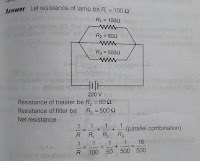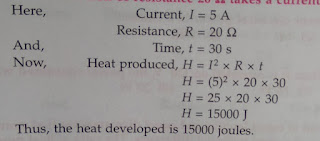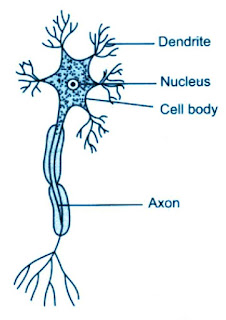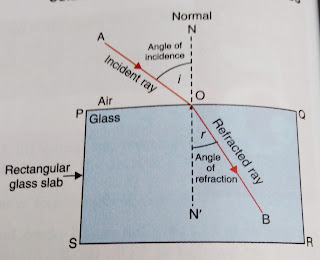NCERT Electricity Text Book Solution ||Class 10
NCERT Electricity Text Book Solution of every sample question with answer for class 10 CBSE Board
NCERT book page 200
Question 1: what does an electric circuit mean?
Answer: are closed and continuous path of electric current is known as electric circuit. When electric circuit is complete that is closed current flow through it but when electric circuit is open then current doesn't flow through it.
Question 2: define the unit of current.
Answer: SI unit of electric current is ampere. When one coulomb of charge flows through any cross section of a conductor in one second, the current flowing through it is said to be one ampere.
Question 3: calculate the number of electrons constituting one coulomb of charge.
Answer: we know that value of charge of an electron e =
NCERT textbook page 202
Question number 1: name a device that helps to maintain a potential difference across a conductor.
Answer: potential difference across a conductor can be maintained by means of a battery consisting of one or more cells.
Question number 2: what is meant by saying that the potential difference between two points is one volt?
Answer: the potential difference between two points is said to be one volt is one Joule of work is done in moving one coulomb of electric charge from one point to the other.
Question 3: how much energy is given to each coulomb of charge passing through a 6 volt battery?
Answer: Q=1C
V=6V
W=VQ= 6×1=6J
6 JOULE IS GIVEN TO EACH COULOMB OF CHARGE PASSING THROUGH A 6 VOLT BATTERY.
NCERT book page 209
Question 1: on what factors does the resistance of a conductor depend?
Answer: the resistance of a conductor depends on
(I) its length. (ii) its area of cross section. (iii) the nature of the material of the conductor, and (IV) the temperature of the conductor.
Question number 2: will current flow more easily through a thick wire or a thin wire of the same material, when connected to the same source? Why?
Answer: the current flows more easily through a thick wire as compared to a thin wire of the same material when connected to the same source. it is due to the reason that resistance of a thick wire is less than that of a thin wire.
Question 3 : let the resistance of an electrical component remains constant while the potential difference across the two ends of the component decreases to half of its former value. What change will occur in the current through it?
Answer: let resistance be R. Potential difference v s cross the two ends becomes V/2
Since. I=V/R
as V=> V/2
I'M= V/2R = I/2
IN OTHER WORDS, current through the component becomes half of its original value.
Question 4: why are coils of electric stores stores and electric irons made of an alloy rather than pure metal?
Answer : because (I) the resistivity of an alloy is much higher than that of a pure metal
(ii) an alloy does not undergo oxidation easily even at high temperature, when it is Red hot.
Question 5: use the data in table on page 23 of this book to answer the following:
(a) which among iron and mercury is a better conductor?
(b) which material is the best conductor?
Answer: (a) the electrical resistivity of iron is 10.0x10⁻⁸ohm metre
(b) silver metal has the lowest electrical resistivity therefore silver metal is the best conductor of electricity.
NCERT book page 213
Question 1: draw a schematic diagram of a circuit consisting of a battery of three cells of 2 volt each, a 5ohm register, an 8 ohm resistor, and a 12 ohm registor, ant black key all connected in series.
Question 2: redraw the circuit of question. Putting an ammeter to measure the current through the resistors and a voltmeter to measure the potential difference across the 12 ohm resistor. What would be the reading in the ammeter and voltmeter?
Answer:
Equivalent resistance of the circuit=R1+R2+R3
= (5+8+12)ohm =12 ohm
Current flowing through the circuit=V/R =6V/ 25ohm = 0.24 A
Therefore ammeter reading=0. 24 ampere
(a) in series combination current flowing through all the resistance is same and is equal to the total current drawn from the source.
Potential difference across 12 Ohm resistor = IR3 = o.24×12= 2.88V
Therefore voltmeter reading =2. 88 volt.
CBSE NCERT book page 216
Question 1: judge the equivalent resistance when the following are connected in parallel (a) 1 ohm and 10 ⁶ ohm. (b) 1ohm and 10⁶ ohm. and 10³ ohm.
Answer: (a) one ohm
(b) one ohm
Question 2: an electric lamp of 100ohm a toaster of resistance 50 ohm, and a water filter of resistance 500 ohm are connected in parallel to a 220 volt source. what is the resistance of an electric iron connected to the same source that takes as much current as all three appliances and what is the current through it?
Answer:
what are the advantages of connecting electrical devices in parallel with the battery instead of connecting them in series?
Answer: (1) if one electrical device is damage d then other devices still work
(2) there is separate on off switch can be applied
(3) voltage across each electrical device is same
(4) total resistance in parallel circuit decreases in Greater current may be drawn from the cell.
Question 4: how can three resistors of resistance 2,3,6ohm be connected to give a total resistance of (a) 4ohm. (b) 1ohm?
Answer: if we connect resistance of 3 ohm 6ohm internal and then resistance of 2 ohm is connected in series of the combination the total resistance of combination is 4 ohm ohm as shown in figure. The com. Resistance R' of The parallel grouping of 3 ohm and 6 ohm resistance is
And total resistance of entire combination R = 2+R' = 2+2=4 ohm
(b) if all the three resistance are joined in parallel then
Question 5: what is (a) the highest (b) the lowest total resistance that can be secured by combinations of four walls of resistance 4,8,12,24 ohm?
Answer: (a) in series we get highest resistance
Rs = R1+R2+R3+R4 =4+8+12+24= 48 ohm
(b) to obtain lowest resistance all the four resistance are connected in parallel arrangement
Text book solution page number 218
Question number 1: why does the cord of an electric heater not glow while the heating element does?
Answer: the heating element of an electric heater is made of an alloy resistance whereas the cord is made of copper metal which has very very low resistance. now the heating element of an electric heater made of nichrome glows because it becomes red or due to the large amount of heat produced on passing current.
the connecting Court of electric heater made of copper does not glow because negligible heat is produced we eat by passing the same current.
Question 2: compute the heat generated while transferring 96000 coulombs of charge in one hour through a potential difference of 50v.
Question number 3: an electric iron of resistance 20 ohm ohm takes a current of 5 ampere. Calculate the heat developed in 30 second.
Answer:
Page number 220
Question number 1: what determines the rate at which energy is delivered by the current?
Answer: electric power determines the rate at which energy is delivered by a current.
More Related Search For You
NCERT book page 200
Question 1: what does an electric circuit mean?
Answer: are closed and continuous path of electric current is known as electric circuit. When electric circuit is complete that is closed current flow through it but when electric circuit is open then current doesn't flow through it.
Question 2: define the unit of current.
Answer: SI unit of electric current is ampere. When one coulomb of charge flows through any cross section of a conductor in one second, the current flowing through it is said to be one ampere.
Question 3: calculate the number of electrons constituting one coulomb of charge.
Answer: we know that value of charge of an electron e =
NCERT textbook page 202
Question number 1: name a device that helps to maintain a potential difference across a conductor.
Answer: potential difference across a conductor can be maintained by means of a battery consisting of one or more cells.
Question number 2: what is meant by saying that the potential difference between two points is one volt?
Answer: the potential difference between two points is said to be one volt is one Joule of work is done in moving one coulomb of electric charge from one point to the other.
Question 3: how much energy is given to each coulomb of charge passing through a 6 volt battery?
Answer: Q=1C
V=6V
W=VQ= 6×1=6J
6 JOULE IS GIVEN TO EACH COULOMB OF CHARGE PASSING THROUGH A 6 VOLT BATTERY.
NCERT book page 209
Question 1: on what factors does the resistance of a conductor depend?
Answer: the resistance of a conductor depends on
(I) its length. (ii) its area of cross section. (iii) the nature of the material of the conductor, and (IV) the temperature of the conductor.
Question number 2: will current flow more easily through a thick wire or a thin wire of the same material, when connected to the same source? Why?
Answer: the current flows more easily through a thick wire as compared to a thin wire of the same material when connected to the same source. it is due to the reason that resistance of a thick wire is less than that of a thin wire.
Question 3 : let the resistance of an electrical component remains constant while the potential difference across the two ends of the component decreases to half of its former value. What change will occur in the current through it?
Answer: let resistance be R. Potential difference v s cross the two ends becomes V/2
Since. I=V/R
as V=> V/2
I'M= V/2R = I/2
IN OTHER WORDS, current through the component becomes half of its original value.
Question 4: why are coils of electric stores stores and electric irons made of an alloy rather than pure metal?
Answer : because (I) the resistivity of an alloy is much higher than that of a pure metal
(ii) an alloy does not undergo oxidation easily even at high temperature, when it is Red hot.
Question 5: use the data in table on page 23 of this book to answer the following:
(a) which among iron and mercury is a better conductor?
(b) which material is the best conductor?
Answer: (a) the electrical resistivity of iron is 10.0x10⁻⁸ohm metre
Since the resistivity of iron is less than that of Mercury, therefore iron is a better conductor than Mercury.Whereas that of mercury is 94. 0×10⁻ ⁸ ohm metre
(b) silver metal has the lowest electrical resistivity therefore silver metal is the best conductor of electricity.
NCERT book page 213
Question 1: draw a schematic diagram of a circuit consisting of a battery of three cells of 2 volt each, a 5ohm register, an 8 ohm resistor, and a 12 ohm registor, ant black key all connected in series.
Question 2: redraw the circuit of question. Putting an ammeter to measure the current through the resistors and a voltmeter to measure the potential difference across the 12 ohm resistor. What would be the reading in the ammeter and voltmeter?
Answer:
Equivalent resistance of the circuit=R1+R2+R3
= (5+8+12)ohm =12 ohm
Current flowing through the circuit=V/R =6V/ 25ohm = 0.24 A
Therefore ammeter reading=0. 24 ampere
(a) in series combination current flowing through all the resistance is same and is equal to the total current drawn from the source.
Potential difference across 12 Ohm resistor = IR3 = o.24×12= 2.88V
Therefore voltmeter reading =2. 88 volt.
CBSE NCERT book page 216
Question 1: judge the equivalent resistance when the following are connected in parallel (a) 1 ohm and 10 ⁶ ohm. (b) 1ohm and 10⁶ ohm. and 10³ ohm.
Answer: (a) one ohm
(b) one ohm
Question 2: an electric lamp of 100ohm a toaster of resistance 50 ohm, and a water filter of resistance 500 ohm are connected in parallel to a 220 volt source. what is the resistance of an electric iron connected to the same source that takes as much current as all three appliances and what is the current through it?
Answer:
what are the advantages of connecting electrical devices in parallel with the battery instead of connecting them in series?
Answer: (1) if one electrical device is damage d then other devices still work
(2) there is separate on off switch can be applied
(3) voltage across each electrical device is same
(4) total resistance in parallel circuit decreases in Greater current may be drawn from the cell.
Question 4: how can three resistors of resistance 2,3,6ohm be connected to give a total resistance of (a) 4ohm. (b) 1ohm?
Answer: if we connect resistance of 3 ohm 6ohm internal and then resistance of 2 ohm is connected in series of the combination the total resistance of combination is 4 ohm ohm as shown in figure. The com. Resistance R' of The parallel grouping of 3 ohm and 6 ohm resistance is
And total resistance of entire combination R = 2+R' = 2+2=4 ohm
(b) if all the three resistance are joined in parallel then
Question 5: what is (a) the highest (b) the lowest total resistance that can be secured by combinations of four walls of resistance 4,8,12,24 ohm?
Answer: (a) in series we get highest resistance
Rs = R1+R2+R3+R4 =4+8+12+24= 48 ohm
(b) to obtain lowest resistance all the four resistance are connected in parallel arrangement
Text book solution page number 218
Question number 1: why does the cord of an electric heater not glow while the heating element does?
Answer: the heating element of an electric heater is made of an alloy resistance whereas the cord is made of copper metal which has very very low resistance. now the heating element of an electric heater made of nichrome glows because it becomes red or due to the large amount of heat produced on passing current.
the connecting Court of electric heater made of copper does not glow because negligible heat is produced we eat by passing the same current.
Question 2: compute the heat generated while transferring 96000 coulombs of charge in one hour through a potential difference of 50v.
Question number 3: an electric iron of resistance 20 ohm ohm takes a current of 5 ampere. Calculate the heat developed in 30 second.
Answer:
Page number 220
Question number 1: what determines the rate at which energy is delivered by the current?
Answer: electric power determines the rate at which energy is delivered by a current.










